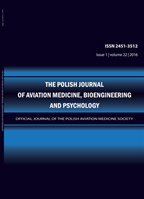2020, Volume 26, Issue 2
PRELIMINARY ANALYSIS OF BRAIN PERFUSION OBTAINED WITH ARTERIAL SPIN LABELING METHOD (ASL) USED TO EVALUATE THE EFFECTS OF TYPE 2 DIABETES IN MORBIDLY OBESE PATIENTS
ANNA KĘDZIORA1, MICHAŁ KACPRZAK2, EWA PIĄTKOWSKA-JANKO1
-------------------------------------------------------------------------------------------------
1Institute of Radioelectronics and Multimedia Technology, Warsaw University of Technology
2Nalecz Institute of Biocybernetics and Biomedical Engineering, Polish Academy of Sciences
Autor korenspondencyjny: EWA PIĄTKOWSKA-JANKO; Institute of Radioelectronics and Multimedia Technology, Warsaw University of Technology; email: ewa.piatkowska@pw.edu.pl
Full text
Streszczenie
Introduction: Earlier studies demonstrated that obesity was associated with lower cerebral perfusion in obese participants, as compared to participants at normal weight, especially in frontal grey matter regions. On the other hand, type 2 diabetes is a common co-morbid condition among obese patients, and it is associated per se with brain structural and metabolic abnormalities that are related to lower cerebral blood flow (CBF). Unfortunately, only two studies evaluated the effects on co-morbid T2D on CBF, one of them in adolescent population. Therefore, the aim of this study was to establish a pipeline process to quantify CBF images that were obtained in an independent project evaluating brain abnormalities associated with morbid obesity and their resolution with intragastric balloon – an invasive method to reduce weight. Furthermore, we compared CBF between obese patients with and without type 2 diabetes, as well as controls at normal weight.
Methods: A processing pipeline utilizing SPM12 toolbox and digital maps (AAL, Brodmann) was established to automatically pre-process scans and toolbox REX was used to prepare data for statistical analysis. We used it to analyze data for six morbidly obese patients with type 2 diabetes T2D (O-T2D) (average age = 48.5 ± 7.9, average body weight = 125.0 ± 29.8 kg, average BMI = 42.0 ± 9.4), eight morbidly obese patients without T2D (O-NT2D) (average age = 39.1 ± 16.1, average body weight = 138.2 ± 14.9 kg, average BMI = 50.2 ± 6.5) and eight healthy controls with normal weight (CON) (average age = 43.5 ± 11.5, average body weight = 67.4 ± 14.6 kg, average BMI = 23.4 ± 3.5). All studies were performed at the CNS Lab MRI Centre, NIBBE.
Results: These preliminary analyses demonstrated lower cerebral blood flow in frontal cortex in obese patients with T2D, as compared to obese patients without T2D and controls.
Conclusion: A pipeline to numerically process ASL-CBF data was created and used to analyse the small dataset. The analyses indicated that not morbid obesity per se, but morbid obesity combined with co-morbid type 2 diabetes is associated with widespread reductions in cerebral perfusion. The results are in line with other studies that were limited to subjects with lower stages of overweight and obesity. We believe that this methodology may be applied to study changes in brain perfusion evoked by simulated hypergravity with Lower Body Negative Pressure (LBNP) device placed within a magnetic resonance scanner or perfusion changes induced by hypoxia.
Słowa kluczowe
arterial spin labelling, cerebral blood flow, pre-processing, brain atlas, statistical analysis, Matlab, SPM12
